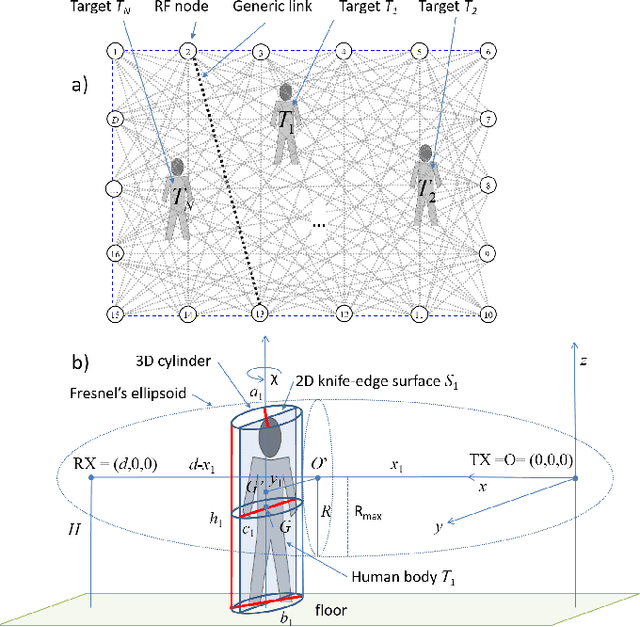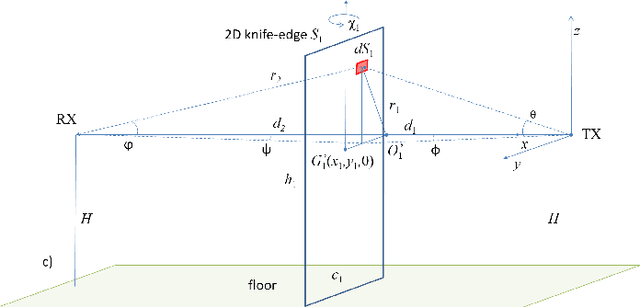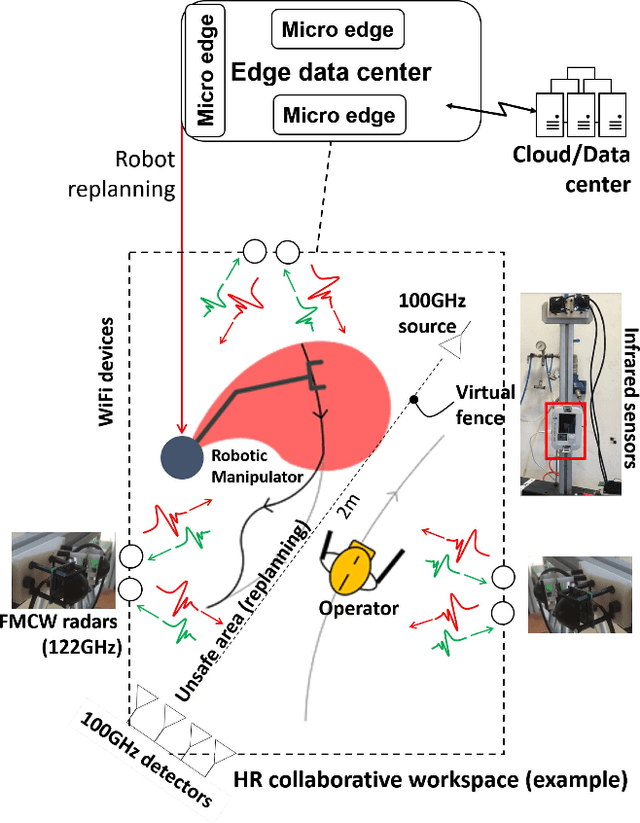Vittorio Rampa
Full-wave EM simulation analysis of human body blockage by dense 2D antenna arrays
May 15, 2024Abstract:Recently, proposals of human-sensing-based services for cellular and local area networks have brought indoor localization to the attention of several research groups. In response to these stimuli, various Device-Free Localization (DFL) techniques, also known as Passive Localization methods, have emerged by exploiting ambient signals to locate and track individuals that do not carry any electronic device. This study delves into human passive indoor localization through full-wave electromagnetic simulations. For the scope, we exploit simulations from the commercial tool FEKO software that employs the Method of Moments (MoM). In particular, we collect and analyze the electric field values in a scenario constituted by a dense 2D/3D deployment of receivers in the presence of an anthropomorphic mobile target. The paper describes in detail the collected dataset and provides a first analysis based on a statistical approach. Possible use cases are also investigated through examples in the context of passive localization, sensing, and imaging.
On the impact of the antenna radiation patterns in passive radio sensing
May 15, 2024Abstract:Electromagnetic (EM) body models based on the scalar diffraction theory allow to predict the impact of subject motions on the radio propagation channel without requiring a time-consuming full-wave approach. On the other hand, they are less effective in complex environments characterized by significant multipath effects. Recently, emerging radio sensing applications have proposed the adoption of smart antennas with non-isotropic radiation characteristics to improve coverage.This letter investigates the impact of antenna radiation patterns in passive radio sensing applications. Adaptations of diffraction-based EM models are proposed to account for antenna non-uniform angular filtering. Next, we quantify experimentally the impact of diffraction and multipath disturbance components on radio sensing accuracy in environments with smart antennas.
Physics-informed generative neural networks for RF propagation prediction with application to indoor body perception
May 03, 2024Abstract:Electromagnetic (EM) body models designed to predict Radio-Frequency (RF) propagation are time-consuming methods which prevent their adoption in strict real-time computational imaging problems, such as human body localization and sensing. Physics-informed Generative Neural Network (GNN) models have been recently proposed to reproduce EM effects, namely to simulate or reconstruct missing data or samples by incorporating relevant EM principles and constraints. The paper discusses a Variational Auto-Encoder (VAE) model which is trained to reproduce the effects of human motions on the EM field and incorporate EM body diffraction principles. Proposed physics-informed generative neural network models are verified against both classical diffraction-based EM tools and full-wave EM body simulations.
An EM Body Model for Device-Free Localization with Multiple Antenna Receivers: A First Study
May 02, 2024Abstract:Device-Free Localization (DFL) employs passive radio techniques capable to detect and locate people without imposing them to wear any electronic device. By exploiting the Integrated Sensing and Communication paradigm, DFL networks employ Radio Frequency (RF) nodes to measure the excess attenuation introduced by the subjects (i.e., human bodies) moving inside the monitored area, and to estimate their positions and movements. Physical, statistical, and ElectroMagnetic (EM) models have been proposed in the literature to estimate the body positions according to the RF signals collected by the nodes. These body models usually employ a single-antenna processing for localization purposes. However, the availability of low-cost multi-antenna devices such as those used for WLAN (Wireless Local Area Network) applications and the timely development of array-based body models, allow us to employ array-based processing techniques in DFL networks. By exploiting a suitable array-capable EM body model, this paper proposes an array-based framework to improve people sensing and localization. In particular, some simulations are proposed and discussed to compare the model results in both single- and multi-antenna scenarios. The proposed framework paves the way for a wider use of multi-antenna devices (e.g., those employed in current IEEE 802.11ac/ax/be and forthcoming IEEE 802.11be networks) and novel beamforming algorithms for DFL scenarios.
A physics-informed generative model for passive radio-frequency sensing
Oct 06, 2023



Abstract:Electromagnetic (EM) body models predict the impact of human presence and motions on the Radio-Frequency (RF) stray radiation received by wireless devices nearby. These wireless devices may be co-located members of a Wireless Local Area Network (WLAN) or even cellular devices connected with a Wide Area Network (WAN). Despite their accuracy, EM models are time-consuming methods which prevent their adoption in strict real-time computational imaging problems and Bayesian estimation, such as passive localization, RF tomography, and holography. Physics-informed Generative Neural Network (GNN) models have recently attracted a lot of attention thanks to their potential to reproduce a process by incorporating relevant physical laws and constraints. Thus, GNNs can be used to simulate/reconstruct missing samples, or learn physics-informed data distributions. The paper discusses a Variational Auto-Encoder (VAE) technique and its adaptations to incorporate a relevant EM body diffraction method with applications to passive RF sensing and localization/tracking. The proposed EM-informed generative model is verified against classical diffraction-based EM body tools and validated on real RF measurements. Applications are also introduced and discussed.
On the Energy and Communication Efficiency Tradeoffs in Federated and Multi-Task Learning
Dec 02, 2022



Abstract:Recent advances in Federated Learning (FL) have paved the way towards the design of novel strategies for solving multiple learning tasks simultaneously, by leveraging cooperation among networked devices. Multi-Task Learning (MTL) exploits relevant commonalities across tasks to improve efficiency compared with traditional transfer learning approaches. By learning multiple tasks jointly, significant reduction in terms of energy footprints can be obtained. This article provides a first look into the energy costs of MTL processes driven by the Model-Agnostic Meta-Learning (MAML) paradigm and implemented in distributed wireless networks. The paper targets a clustered multi-task network setup where autonomous agents learn different but related tasks. The MTL process is carried out in two stages: the optimization of a meta-model that can be quickly adapted to learn new tasks, and a task-specific model adaptation stage where the learned meta-model is transferred to agents and tailored for a specific task. This work analyzes the main factors that influence the MTL energy balance by considering a multi-task Reinforcement Learning (RL) setup in a robotized environment. Results show that the MAML method can reduce the energy bill by at least 2 times compared with traditional approaches without inductive transfer. Moreover, it is shown that the optimal energy balance in wireless networks depends on uplink/downlink and sidelink communication efficiencies.
An Energy and Carbon Footprint Analysis of Distributed and Federated Learning
Jun 21, 2022



Abstract:Classical and centralized Artificial Intelligence (AI) methods require moving data from producers (sensors, machines) to energy hungry data centers, raising environmental concerns due to computational and communication resource demands, while violating privacy. Emerging alternatives to mitigate such high energy costs propose to efficiently distribute, or federate, the learning tasks across devices, which are typically low-power. This paper proposes a novel framework for the analysis of energy and carbon footprints in distributed and federated learning (FL). The proposed framework quantifies both the energy footprints and the carbon equivalent emissions for vanilla FL methods and consensus-based fully decentralized approaches. We discuss optimal bounds and operational points that support green FL designs and underpin their sustainability assessment. Two case studies from emerging 5G industry verticals are analyzed: these quantify the environmental footprints of continual and reinforcement learning setups, where the training process is repeated periodically for continuous improvements. For all cases, sustainability of distributed learning relies on the fulfillment of specific requirements on communication efficiency and learner population size. Energy and test accuracy should be also traded off considering the model and the data footprints for the targeted industrial applications.
Electromagnetic Models for Passive Detection and Localization of Multiple Bodies
Apr 15, 2021



Abstract:The paper proposes a multi-body electromagnetic (EM) model for the quantitative evaluation of the influence of multiple human bodies in the surroundings of a radio link. Modeling of human-induced fading is the key element for the development of real-time Device-Free (or passive) Localization (DFL) and body occupancy tracking systems based on the processing of the Received Signal Strength (RSS) data recorded by radio-frequency devices. The proposed physical-statistical model, is able to relate the RSS measurements to the position, size, orientation, and random movements of people located in the link area. This novel EM model is thus instrumental for crowd sensing, occupancy estimation and people counting applications for indoor and outdoor scenarios. The paper presents the complete framework for the generic N-body scenario where the proposed EM model is based on the knife-edge approach that is generalized here for multiple targets. The EM-equivalent size of each target is then optimized to reproduce the body-induced alterations of the free space radio propagation. The predicted results are then compared against the full EM simulations obtained with a commercially available simulator. Finally, experiments are carried out to confirm the validity the proposed model using IEEE 802.15.4-compliant industrial radio devices.
A Multisensory Edge-Cloud Platform for Opportunistic Radio Sensing in Cobot Environments
Mar 26, 2021



Abstract:Worker monitoring and protection in collaborative robot (cobots) industrial environments requires advanced sensing capabilities and flexible solutions to monitor the movements of the operator in close proximity of moving robots. Collaborative robotics is an active research area where Internet of Things (IoT) and novel sensing technologies are expected to play a critical role. Considering that no single technology can currently solve the problem of continuous worker monitoring, the paper targets the development of an IoT multisensor data fusion (MDF) platform. It is based on an edge-cloud architecture that supports the combination and transformation of multiple sensing technologies to enable the passive and anonymous detection of workers. Multidimensional data acquisition from different IoT sources, signal pre-processing, feature extraction, data distribution and fusion, along with machine learning (ML) and computing methods are described. The proposed IoT platform also comprises a practical solution for data fusion and analytics. It is able to perform opportunistic and real-time perception of workers by fusing and analyzing radio signals obtained from several interconnected IoT components, namely a multi-antenna WiFi installation (2.4-5 GHz), a sub-THz imaging camera (100 GHz), a network of radars (122 GHz) and infrared sensors (8-13 {\mu}m). The performance of the proposed IoT platform is validated through real use case scenarios inside a pilot industrial plant in which protective human--robot distance must be guaranteed considering latency and detection uncertainties.
A Framework for Energy and Carbon Footprint Analysis of Distributed and Federated Edge Learning
Mar 18, 2021



Abstract:Recent advances in distributed learning raise environmental concerns due to the large energy needed to train and move data to/from data centers. Novel paradigms, such as federated learning (FL), are suitable for decentralized model training across devices or silos that simultaneously act as both data producers and learners. Unlike centralized learning (CL) techniques, relying on big-data fusion and analytics located in energy hungry data centers, in FL scenarios devices collaboratively train their models without sharing their private data. This article breaks down and analyzes the main factors that influence the environmental footprint of FL policies compared with classical CL/Big-Data algorithms running in data centers. The proposed analytical framework takes into account both learning and communication energy costs, as well as the carbon equivalent emissions; in addition, it models both vanilla and decentralized FL policies driven by consensus. The framework is evaluated in an industrial setting assuming a real-world robotized workplace. Results show that FL allows remarkable end-to-end energy savings (30%-40%) for wireless systems characterized by low bit/Joule efficiency (50 kbit/Joule or lower). Consensus-driven FL does not require the parameter server and further reduces emissions in mesh networks (200 kbit/Joule). On the other hand, all FL policies are slower to converge when local data are unevenly distributed (often 2x slower than CL). Energy footprint and learning loss can be traded off to optimize efficiency.
 Add to Chrome
Add to Chrome Add to Firefox
Add to Firefox Add to Edge
Add to Edge